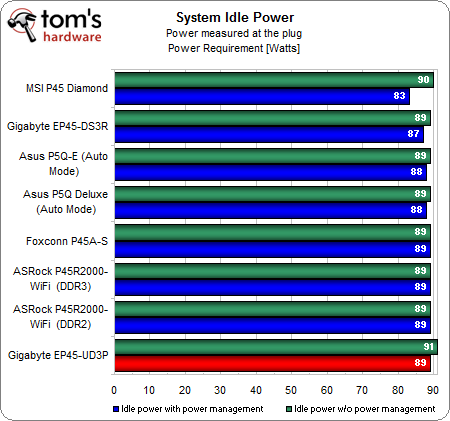Ultra Durable 3: Extra Copper, Benchmarked
Idle And Peak Power, DES Efficiency
Despite Gigabyte’s claims of possible power savings, the EP45-UD3P doesn’t make a difference. If we were picky we could write about the 2 W power requirement increase when compared to the EP45-DS3R and other boards, which don’t come with additional copper.
Things look different when we look at peak power. In this case, the UD3P motherboard does well, although it still cannot beat the EP45-DS3R, which required less peak power.
In this test we compared the system idle power without Gigabyte’s DES power saving technology, versus the DES automatic mode. We also included some of the other products that offer comparable power saving mechanisms. The result shows the power saving advantage when the appropriate power saving feature was enabled. Intel’s Enhanced SpeedStep technology, which reduces clock speed and processor voltdage in idle, was enabled in every case, as it is a processor feature.
We repeated the power saving feature test at peak processor load and were surprised: Gigabyte’s DES only introduces a 1.7% power savings when the processor runs at peak power. The Asus EPU6 even led to a slight increase in system power consumption, while only MSI’s P45 Diamond with its DrMOS voltage regulator switching introduces substantial savings. Again, Ultra Durable 3 didn’t make a difference.
Get Tom's Hardware's best news and in-depth reviews, straight to your inbox.
Current page: Idle And Peak Power, DES Efficiency
Prev Page Results: SYSmark 2007 Preview Next Page Performance Per Watt And Temperature


